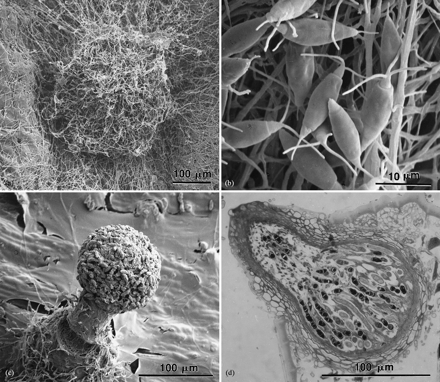Only in our planet oceans, around 46.000 pieces of plastic debris, known as nurdles, are floating in each square mile, killing up to 1 million sea birds 100 thousand sea mammals adding to an unknown number of countless fish, each year.
Moreover, as far as we Humans are concerned, bisphenol A, more known as BPA, the main dioxin released by plastic containers into food and bottled water, as reached a detectable level in 93% of the people in developed countries. BPA has been long ago proven to be a carcinogen element to the Human body. Not only that, also BPA’s are proven to induce cardiovascular disease, age and puberty, obesity and developmental disorders.
 |
| Primary fruiting structures of Pestalotiopsis microspora and Pestalosphaeria hansenii: (a) an acervulus of Pestalotiopsis microspora; (b) appendage-bearing conidiospores of Pestalotiopsis microspora; (c) a perithicium of Pestalosphaeria hansenii with an agglutinated mass of ascospores; (d) the asci of Pestalosphaeria hansenii located within a perithecium. |
Due to it’s low rate of biodegradability, known to be able to take up to thousand of years to succeed, the amount of landfill goes up to 25% of all worldwide waste deposits, being from far the most comment element in them.
Being on the top of the environmental issues, a University of Yale team has recently performed a research on plastic eating fungi, and found a mushroom creating fungus able to bio-degrade polymer polyurethan, one of the most common type of worldwide produced plastic.
The Amazon is home to more species than almost anywhere else on earth. One of them, carried home recently by a group from Yale University, appears to be quite happy eating plastic in airless landfills.
The group of students, part of Yale’s annual Rainforest Expedition and Laboratory with molecular biochemistry professor Scott Strobel, ventured to the jungles of Ecuador. The mission was to allow "students to experience the scientific inquiry process in a comprehensive and creative way." The group searched for plants, and then cultured the microorganisms within the plant tissue. As it turns out, they brought back a fungus new to science with a voracious appetite for a global waste problem: polyurethane.
The fungi, Pestalotiopsis microspora, is the first anyone has found to survive on a steady diet of polyurethane alone and--even more surprising--do this in an anaerobic (oxygen-free) environment that is close to the condition at the bottom of a landfill.
Student Pria Anand recorded the microbe’s remarkable behavior and Jonathan Russell isolated the enzymes that allow the organism to degrade plastic as its food source. The Yale team published their findings in the journal Applied and Environmental Microbiologylate last year concluding the microbe is "a promising source of biodiversity from which to screen for metabolic properties useful for bioremediation." In the future, our trash compactors may simply be giant fields of voracious fungi.
Who knows what the students in the rainforest will turn up next?
http://aem.asm.org/content/77/17/6076


Why not just educate the human race not to throw any form of rubbish into the sea drains road side/streets, , Be responsible or take heavy finds. This playing with Bio funk could trigger something els that may go air born , Or effect use of lactic piping for drinking water, or under sea cables. Sanitary control,
ReplyDelete